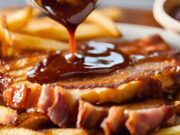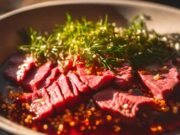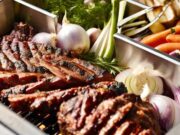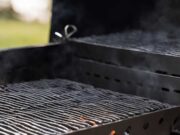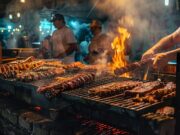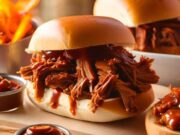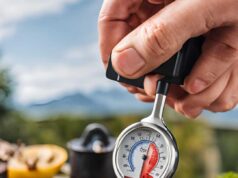- Key Takeaways:
- Understanding Charcoal and Its Combustion
- The Importance of Grill Vents
- Types of Vents on Your Charcoal Grill
- How Airflow Affects Temperature Control
- Adjusting Vents for Different Cooking Methods
- Techniques for Raising and Lowering Grill Temperature
- Managing Flare-Ups and Maintaining Consistent Heat
- Common Mistakes to Avoid
- Frequently Asked Questions
Mastering the art of cooking with a charcoal grill involves more than simply lighting the coals; it centers on effective temperature control, with a significant factor being the grill’s vents.
This guide delves into the interaction of air and heat that can enhance your grilling proficiency. By understanding the mechanics of charcoal combustion and the essential roles of intake and exhaust dampers, you will gain practical tips and techniques to achieve a perfectly grilled meal every time.
You will learn how to adjust vents for different cooking methods, manage flare-ups, and avoid common pitfalls that may hinder your grilling experience. Prepare to elevate your charcoal grilling skills to a professional level.
Key Takeaways:
- Properly managing the vents on your charcoal grill is crucial for achieving the desired temperature for cooking.
- Understanding the different types of vents and how they affect airflow can help you control the temperature and avoid flare-ups.
- Adjusting the vents according to your cooking method and using techniques to raise or lower the temperature can help you master your grill and produce delicious meals.

Understanding Charcoal and Its Combustion
Understanding charcoal and its combustion process is essential for anyone aiming to master the art of grilling, as the type of charcoal you select can greatly influence the heat and flavor of your food.
Among the various options available, lump charcoal is noteworthy for its natural composition and quick ignition, generating intense heat that is ideal for grilling meats to perfection. Conversely, hardwood charcoal imparts a distinctive smoky flavor, elevating the overall taste profile of your grilled dishes.
When choosing the right type of charcoal, it is important to consider your cooking method and desired flavor outcome. For instance, lump charcoal may be the preferred choice for those seeking high temperatures, while briquettes provide a more controlled burn.
To effectively manage your fire, employ techniques such as adjusting airflow and gradually adding charcoal, which will help ensure an evenly cooked meal every time.
The Importance of Grill Vents
Grill vents play a critical role in temperature control and oxygen management, significantly influencing the cooking temperature of your charcoal grill. The intake damper located at the bottom vent allows fresh oxygen to nourish the fire, while the exhaust vent at the lid regulates heat levels by allowing smoke and heat to escape. Proper manipulation of these vents can lead to more effective grilling techniques, whether you are aiming for high heat to sear meats or lower temperatures for slow-roasting vegetables or sweet potatoes.
Understanding how grill vents function can significantly enhance your outdoor cooking experience. By adjusting the bottom intake damper, you can control the amount of oxygen entering the grill, thereby intensifying or cooling the fire. For example, when searing proteins, opening the vents wider creates a hotter blaze, while partially closing them during indirect cooking helps maintain stable, lower temperatures.
During longer cooking sessions, such as preparing brisket or ribs, keeping the top vent partially open allows smoke to escape, enhancing flavor without causing excessive drops in temperature. Fine-tuning these settings not only improves your grilling results but also fosters a deeper understanding of fire management in the grilling process.
Types of Vents on Your Charcoal Grill
In terms of charcoal grills, understanding the various types of vents is essential for effective heat and smoke management, which impacts everything from cooking temperature to flavor profiles.
There are primarily two types of vents to consider: the bottom vent, often referred to as the intake damper, and the lid vent, known as the exhaust damper. Each vent serves a distinct purpose in controlling oxygen flow; the bottom vent draws in air to fuel the fire, while the lid vent allows heat and smoke to escape, thus regulating the internal temperature of the grill.
The Lower Vent: Intake Damper
The lower vent, often referred to as the intake damper, plays a vital role in managing oxygen flow to the fire in your charcoal grill. By adjusting this vent, you can regulate the amount of oxygen that fuels the flames, which directly affects the heat level and cooking temperature. A fully open intake damper facilitates maximum airflow, resulting in high heat, while partially closing it reduces oxygen levels, creating lower temperatures that are ideal for slow cooking or smoking.
For example, when grilling chicken or thicker cuts of meat, it is advisable to start with the lower vent fully open to achieve a rapid sear and that desirable crispy exterior. After a few minutes, slightly closing the vent will help maintain steady, moderate heat, ensuring even cooking throughout the meat.
When cooking vegetables, which typically require less time, keeping the vent partially open allows for effective caramelization without the risk of overcooking. Utilizing an external thermometer to monitor heat levels can provide you with additional precision, ensuring beautifully grilled food every time.
By adjusting the intake damper according to your specific dish, you can enhance both texture and flavor, significantly improving your overall grilling experience.
The Lid Vent: Exhaust Damper
The lid vent, often referred to as the exhaust damper, is essential for effective heat management and smoke control when grilling with charcoal. This vent facilitates the escape of hot air and smoke, which is crucial for maintaining the ideal cooking temperature and developing flavors in your dishes. By adjusting the lid vent, you can regulate the intensity of the flames and the overall temperature of the grill, making it easier to achieve your desired cooking results, whether grilling sweet potatoes or searing chicken.
Understanding how to manipulate this vent throughout the grilling process can significantly enhance the outcome of your meals. For instance, when starting the grill, leaving the lid vent open promotes better airflow, allowing the charcoal to ignite quickly and reach higher temperatures. As the cooking progresses, especially during slow-cooking or smoking meats, partially closing the vent helps manage heat levels while trapping smoke, which infuses flavor into the food.
Therefore, being mindful of the lid vent’s adjustments not only assists in maintaining optimal temperatures but also plays a key role in achieving that perfect smoky taste appreciated by all BBQ enthusiasts.
How Airflow Affects Temperature Control
Airflow is a crucial element in controlling the temperature of your charcoal grill, directly impacting fire management and the effectiveness of your grilling techniques. By manipulating both the bottom and lid vents, you can create an optimal balance of oxygen that allows for consistent heat levels, which is essential for achieving the right cooking temperature.
Whether you aim to establish a two-zone fire for direct and indirect cooking or simply manage flare-ups, understanding airflow is key to mastering your grill.
The venting system serves not only to regulate the grill’s internal temperature but also to minimize the risk of charred food and unwanted flare-ups that can smoke and ruin your meals. For instance, opening the bottom vent increases airflow and raises the temperature, making it ideal for searing meats, while slightly closing it can help lower the heat when cooking delicate items like fish.
Keeping the lid closed as much as possible maintains heat and creates an even cooking environment. By learning the precise adjustments needed, you can elevate your grilling skills and produce mouthwatering results every time.
Adjusting Vents for Different Cooking Methods
Adjusting the vents on your charcoal grill according to your cooking method is essential for achieving the desired results, whether you are smoking meats or grilling vegetables. For high-heat cooking, such as searing chicken, it is critical to open both the bottom and lid vents to maximize oxygen flow. Conversely, for low and slow methods, like smoking sweet potatoes, you may want to partially close the vents to reduce heat levels and maintain a steady temperature.
Understanding these adjustments can significantly enhance your grilling experience.
By managing airflow effectively, you can control the temperature more precisely, ensuring that every dish is cooked to perfection. For instance, when preparing a brisket, keeping the lid vent fully open while adjusting the bottom vent slightly can create the ideal environment for low-temperature cooking. Utilizing a temperature gauge can further assist you in monitoring heat levels, enabling you to make real-time adjustments.
Experimenting with vent settings will help you become more adept at mastering various grilling techniques, ultimately leading to mouthwatering meals that will impress family and friends.
Techniques for Raising and Lowering Grill Temperature
Mastering the techniques for adjusting grill temperature is essential for any charcoal grilling enthusiast, enabling you to exert precise control over the cooking process. To increase the temperature, simply open the lower vent to allow more oxygen to reach the burning charcoal briquettes. Conversely, to lower the temperature, close the dampers to restrict airflow. Understanding these adjustments not only aids in achieving the ideal cooking temperature but also enhances the flavor and texture of your grilled dishes.
For example, when grilling thicker cuts of meat like steak or pork chops, a hotter grill is crucial for creating that perfect sear on the outside while maintaining juiciness on the inside. In contrast, for more delicate items such as fish or vegetables, lower temperatures can prevent burning and promote even cooking.
Employing a two-zone setup can also be beneficial; by having one side of the grill hot and the other cooler, you can initially sear meat over high heat before transferring it to the cooler side to finish cooking. Experimenting with these temperature techniques can significantly enhance your grilling skills, allowing each meal to showcase the flavor and texture that truly stands out.
Managing Flare-Ups and Maintaining Consistent Heat
Managing flare-ups and maintaining consistent heat are essential elements of successful charcoal grilling, ensuring that your food cooks evenly without the risk of burning. Flare-ups often occur when fat drips onto the flames, so it is important to adjust the vents to control oxygen flow and reduce the intensity of the flames. Keeping a close watch on the temperature and employing techniques such as creating a two-zone fire can help mitigate flare-ups and promote steady cooking conditions.
Along with adjusting the vents, utilizing a drip pan can significantly decrease the likelihood of flare-ups while also adding moisture to your food. Placing the pan directly beneath the cooking grate collects excess grease, preventing it from igniting. For larger cuts of meat, consider using indirect cooking methods to allow for gradual cooking at lower temperatures.
To maintain stable heat, periodically check and replenish your charcoal supply, ensuring that the coals remain hot and evenly distributed. By implementing these practical strategies, you can enhance your outdoor cooking experience and minimize the risk of burnt or unevenly cooked meals.
Common Mistakes to Avoid
Avoiding common mistakes in charcoal grilling can significantly enhance your cooking outcomes, particularly regarding temperature management and fire control. One frequent error is neglecting to adjust the vents adequately, leading to uneven cooking temperatures and unexpected flare-ups. Overloading the grill with food can restrict airflow, exacerbating heat issues and resulting in subpar grilling performance.
Many grillers overlook the importance of properly preheating the grill, which is essential for achieving that perfect sear and flavor. It is also advisable to avoid excessive use of lighter fluid, as it can impart unwanted chemical flavors to your food. Instead, consider alternative ignition methods to enhance the overall taste.
Grilling time can sometimes be miscalculated; many enthusiasts rely on guesswork rather than using a meat thermometer, which can lead to uncertain results. By recognizing these common pitfalls and taking proactive measures, both novice and experienced grillers can elevate their techniques and consistently produce mouth-watering meals.
Frequently Asked Questions
What are the benefits of using vents to control my charcoal grill temperature?
Using vents allows for precise temperature control, resulting in perfectly cooked food. It also helps save on charcoal usage and can prevent flare-ups.
How do I use the vents to control the temperature on my charcoal grill?
Open the vents to increase oxygen flow and raise the temperature, and close them to decrease oxygen flow and lower the temperature. Adjusting the vents in small increments is key to achieving the desired temperature.
Can I use the same vent settings for all types of food?
No, different types of food require different cooking temperatures. It is important to adjust the vents accordingly based on the type of food you are grilling.
How do I know when to adjust the vents?
Monitor the temperature of your grill using a thermometer. If the temperature is too high, close the vents slightly. If the temperature is too low, open the vents slightly. Repeat until desired temperature is reached.
What happens if I close the vents completely?
Closing the vents completely will cut off the oxygen flow and extinguish the fire, causing your coals to burn out. It is important to always have at least one vent open while grilling.
Can I use vents to control the temperature on a gas grill?
No, gas grills do not have vents that can be adjusted to control temperature. Instead, use the temperature control knobs on your gas grill to achieve the desired temperature.








